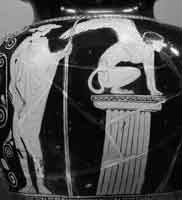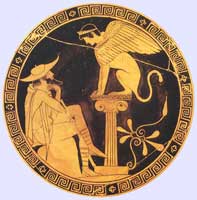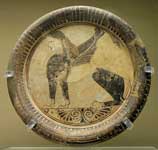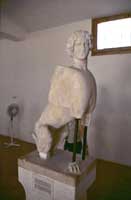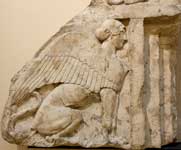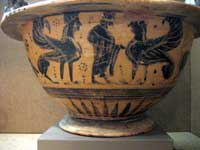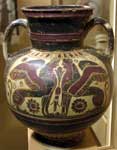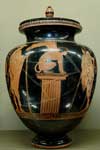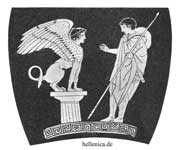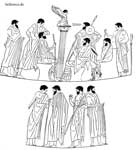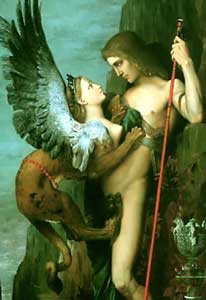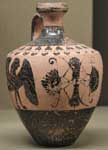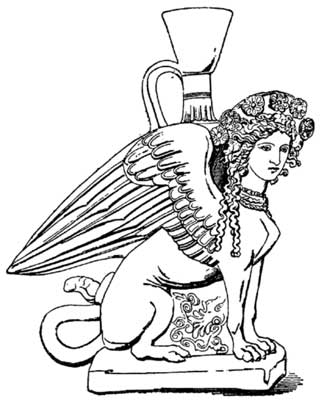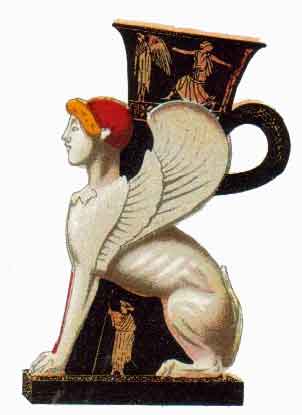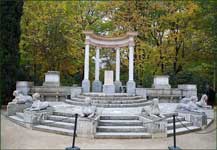.
This is an elegant, instructive fable, and seems invented to represent science, especially as joined with practice. For science may, without absurdity, be called a monster, being strangely gazed at and admired by the ignorant and unskilful. Her figure and form is various, by reason of the vast variety of subjects that science considers; her voice and countenance are represented female, by reason of her gay appearance... Francis Bacon, Sphinx, or Science Explained of the Sciences
A Sphinx (for the archaic spelling Sphynx, revived for a breed of cat and other uses, see below) is an iconic image of a recumbent lion with a human head, invented by the Egyptians of the Old Kingdom, but a cultural import in archaic Greek mythology, where it received its name (Greek Σφιγξ, "strangler").
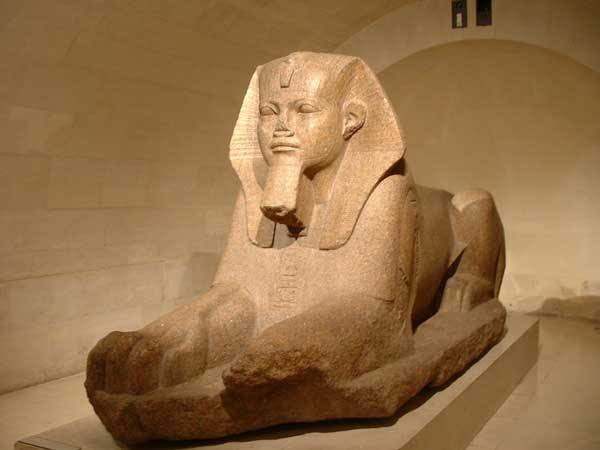
Egyptian Sphinx, Louvre [Source]
Egyptian Sphinx
The Egyptian sphinx is an ancient iconic mythical creature usually comprised of a recumbent lion – an animal with sacred solar associations – with a human head, usually that of a pharaoh.
The Giza Sphinx from Space
The largest and most famous is the Great Sphinx of Giza, which is on the Giza Plateau on the west bank of the Nile River, facing due east, with a small temple between its paws. The face of the Great Sphinx is believed to the head of the pharaoh Khafra (often known by the Hellenised version of his name, Chephren), which would date its construction to the Fourth Dynasty (2723 BC – 2563 BC). However, there are some alternative theories that re-date the Sphinx to pre-Old Kingdom - and, according to one hypothesis, to prehistoric - times.
Other famous Egyptian sphinxes include the alabaster sphinx of Memphis, currently located within the open-air museum at that site; and the ram-headed sphinxes, representing the god Amun, that line either side of the three kilometer route linking the complexes of Luxor Temple and Karnak in Luxor (ancient Thebes), of which there were originally some nine hundred.
What names ancient Egyptians called the statues is unknown. The Arabic name of the Great Sphinx, Abu al-Hôl, translates as "Father of Terror". The Western name "Sphinx" was given to it based on the legendary Greek creature with the body of a lion and the head of a lady, however the Egyptian Great Sphinx has the head of a man, and therefore the name is not technically accurate.
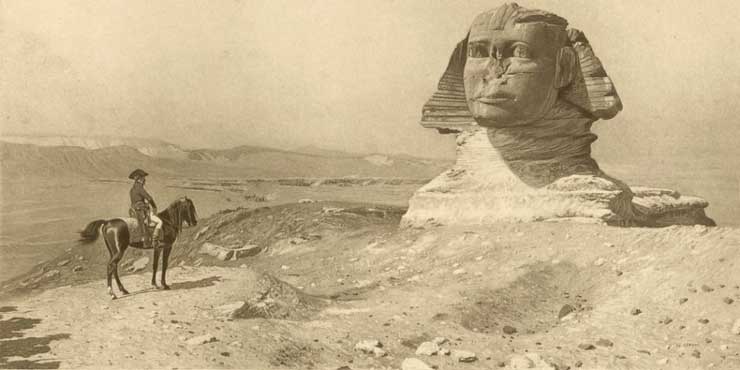
Napoleon Bonaparte and the Sphinx
Greek Sphinx
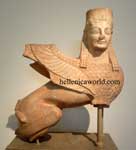
Statue of a Sphinx. Pentelic marble. Found in Spata, Attica.

Sphinx from Naxos in Delphi
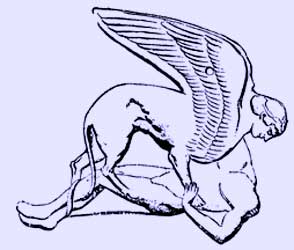
Sphinx victim
There was one Sphinx in Greek mythology. She was a demon of destruction and bad luck, according to Hesiod a daughter of the Chimaera and Orthrus, according to others of Typhon and Echidna. She was represented most often seated upright rather than recumbent, as a winged lion with a woman's head; or she was a woman with the paws, claws and breasts of a lion, a serpent's tail and birdlike wings. Hera or Ares sent her from her Ethiopian homeland (for the Greeks remembered the Sphinx's foreign origins) to sit outside Thebes and ask all passersby history's most famous riddle: "Which creature in the morning goes on four feet, at noon on two, and in the evening upon three?" She strangled anyone who couldn't answer. The word "sphinx" comes from the Greek Σφιγξ, Sphinx, apparently from the verb σφιγγω, sphingo, meaning "to strangle". Oedipus solved the riddle: man, crawls on all fours as a baby then walks on two feet as an adult, and walks with a cane in old age. The Sphinx then threw herself from her high rock and died. In fact, the exact riddle asked by the Sphinx was not specified by early tellers of the story and was not standardised as the one given above until much later in Greek history.
Thus Oedipus can be recognized as a liminal or "threshold" figure, helping effect the transition between the old religious practices, represented by the Sphinx, and new, Olympian ones.
Source: Apollodorus, Library and Epitome , 3.5.8
In his reign a heavy calamity befell Thebes. For Hera sent the Sphinx, whose mother was Echidna and her father Typhon; and she had the face of a woman, the breast and feet and tail of a lion, and the wings of a bird. And having learned a riddle from the Muses, she sat on Mount Phicium, and propounded it to the Thebans. And the riddle was this:- What is that which has one voice and yet becomes four-footed and two-footed and three-footed? Now the Thebans were in possession of an oracle which declared that they should be rid of the Sphinx whenever they had read her riddle; so they often met and discussed the answer, and when they could not find it the Sphinx used to snatch away one of them and gobble him up. When many had perished, and last of all Creon's son Haemon, Creon made proclamation that to him who should read the riddle he would give both the kingdom and the wife of Laius. On hearing that, Oedipus found the solution, declaring that the riddle of the Sphinx referred to man; for as a babe he is four-footed, going on four limbs, as an adult he is two-footed, and as an old man he gets besides a third support in a staff. So the Sphinx threw herself from the citadel, and Oedipus both succeeded to the kingdom and unwittingly married his mother, and begat sons by her, Polynices and Eteocles, and daughters, Ismene and Antigone. But some say the children were borne to him by Eurygania, daughter of Hyperphas.
Similar creatures
Not all human-headed animals of antiquity are sphinxes. In ancient Assyria, for example, bas-reliefs of bulls with the crowned bearded heads of kings guarded the entrances to temples. In the classical Olympian mythology of Greece, all the deities had human form, though they could assume their animal natures as well. All the creatures of Greek myth that combine human and animal form are survivals of the pre-Olympian religion: centaurs, Typhon, Medusa, Lamia.
Mannerist Sphinx
The revived Mannerist Sphinx of the 16th century is sometimes thought of as the French Sphinx. Her lovely coiffed head is erect and she has the pretty bust of a young woman. Often she wears eardrops and pearls. Her body is naturalistically rendered as a recumbent lion. Such Sphinxes were revived when the grottesche or "grotesque" decorations of the unearthed "Golden House" (Domus Aurea) of Nero were brought to light in early 16th century Rome, and she was incorporated into the vocabulary of arabesque designs that was spread throughout Europe in engravings during the 16th and 17th centuries. Her first appearances in French art are in the School of Fontainebleau in the 1520s and 30s; her last appearances are in the Late Baroque style of the French Régence (1715-–1723). Sphinxes were too somber perhaps for the Rococo, and they tended to disappear from the European design repertory.
"Sphynx" and "Sphinx" can refer to many things. These include:
Sphynx: a breed of hairless cat
Sphinx Systems: a Swiss competition pistols manufacturer
Sphinx: a free voice recognition engine
An American test satellite, Sphinx (satellite)
The Egyptian Sphinx
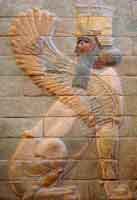
Sphinx from Naxos in Delphi
Art, or The Sphinx, or The Caresses, 1896, Fernand Khnopff (Belgian, 1858-1921) , Musées Royaux des Beaux-Arts, Brussels
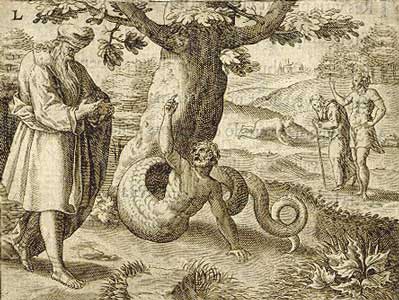
The riddle of the Sphinx, the solution in the background
Sphinx, Madrid, Parque El Capricho
The Sphinx, or, The Caresses , Khnopff, Fernand 1896
See also : Greek Mythology. Paintings, Drawings
Greek Mythology Index
A - B - C - D - E - F - G - H - I - J - K - L - M -
N - O - P - Q - R - S - T - U - V - W - X - Y - Z
Α - Β - Γ - Δ - Ε - Ζ - Η - Θ - Ι - Κ - Λ - Μ -
Ν - Ξ - Ο - Π - Ρ - Σ - Τ - Υ - Φ - Χ - Ψ - Ω
| Ancient Greece
Science, Technology , Medicine , Warfare, , Biographies , Life , Cities/Places/Maps , Arts , Literature , Philosophy ,Olympics, Mythology , History , Images Medieval Greece / Byzantine Empire Science, Technology, Arts, , Warfare , Literature, Biographies, Icons, History Modern Greece Cities, Islands, Regions, Fauna/Flora ,Biographies , History , Warfare, Science/Technology, Literature, Music , Arts , Film/Actors , Sport , Fashion --- |
Retrieved from "http://en.wikipedia.org"
All text is available under the terms of the GNU Free Documentation License

